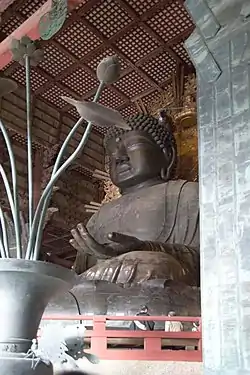大日如来
See also: 大日如來
Chinese
| For pronunciation and definitions of 大日如来 – see 大日如來 (“Vairocana”). (This term, 大日如来, is the simplified form of 大日如來.) |
Notes:
|
Japanese
| Kanji in this term | |||
|---|---|---|---|
| 大 | 日 | 如 | 来 |
| だい Grade: 1 |
にち Grade: 1 |
にょ Grade: S |
らい Grade: 2 |
| on’yomi | |||
Etymology
From Middle Chinese 大日如來 (MC dɑiH ȵiɪt̚ ȵɨʌ lʌi). Compare modern Mandarin 大日如來/大日如来 (Dàrì Rúlái).
Middle Chinese 大日如來 is a compound of 大日 + 如來, where 大日 (literally “great sun”) is a translation of Sanskrit महावैरोचन (Mahāvairocana, the name of this Buddhist entity)[1][2], and 如來 is an abbreviation of either 如去如來 or 如來如去 (“coming from suchness, going back into suchness”), translations of Sanskrit तथागत (tathāgata, “coming from suchness, going back into suchness; thus coming, thus going”, exact meaning uncertain, see ![]()
Pronunciation
Proper noun
大日如来 (hiragana だいにちにょらい, rōmaji Dainichi Nyorai)
- (religion, Buddhism) Dainichi Nyorai: the sun Buddha, called Vairocana or Mahāvairocana; the embodiment of the Buddhist concept of emptiness or sunyata, one of the Five Dhyani Buddhas, and an important entity in Shingon Buddhism
Related terms
Further reading



This article is issued from Wiktionary. The text is licensed under Creative Commons - Attribution - Sharealike. Additional terms may apply for the media files.
